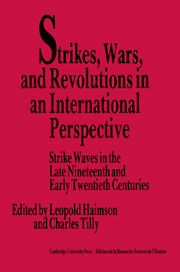 Strikes, Wars, and Revolutions in an International Perspective
Strikes, Wars, and Revolutions in an International Perspective Book contents
- Frontmatter
- Contents
- List of contributors
- Preface
- Part I Introductions
- Part II Models and realities
- Part III Workers in metal-processing enterprises in comparative perspective
- 11 From the mechanic to the metallo
- 12 Strikes of machinists in the United States, 1870–1922
- 13 The political economy of British engineering workers during the First World War
- 14 The rationalization of class struggle: strikes and strike strategy of the German Metalworkers' Union, 1891–1922
- 15 Scientific management and the changing nature of work in the St. Petersburg metalworking industry, 1900–1914
- 16 Structural processes of change and changing patterns of labor unrest: the case of the metal-processing industry in Imperial Russia, 1890–1914
- 17 Social characteristics, attitudes, and patterns of strike behavior of metalworkers in Italy during the First World War
- Part IV The effects of short-term variation
- Part V Conclusion
15 - Scientific management and the changing nature of work in the St. Petersburg metalworking industry, 1900–1914
Published online by Cambridge University Press: 25 March 2010
- Frontmatter
- Contents
- List of contributors
- Preface
- Part I Introductions
- Part II Models and realities
- Part III Workers in metal-processing enterprises in comparative perspective
- 11 From the mechanic to the metallo
- 12 Strikes of machinists in the United States, 1870–1922
- 13 The political economy of British engineering workers during the First World War
- 14 The rationalization of class struggle: strikes and strike strategy of the German Metalworkers' Union, 1891–1922
- 15 Scientific management and the changing nature of work in the St. Petersburg metalworking industry, 1900–1914
- 16 Structural processes of change and changing patterns of labor unrest: the case of the metal-processing industry in Imperial Russia, 1890–1914
- 17 Social characteristics, attitudes, and patterns of strike behavior of metalworkers in Italy during the First World War
- Part IV The effects of short-term variation
- Part V Conclusion
Summary
On the eve of World War I, strike protest in the St. Petersburg metalworking industry was distinguished by a frequency and intensity that was rarely displayed by other workers in the capital or by workers elsewhere in the empire. To a significant degree, it will be argued, this extraordinary level of labor–management conflict was linked to a process of structural change that had been unfolding in the financial, commercial, technological, and managerial organization of the industry, as well as important alterations in the process of production. Reforms had been implemented in response to the sharp economic downturn of the 1900–10 period and to the outbreak of serious labor unrest in 1901 and again in 1905.
The new strategies adopted by Petersburg employers to meet these various challenges were broadly similar to those associated with the managerial reform movement, then enjoying great popularity in the West. Interestingly, however, the ideas of “scientific management” were first explored and partially implemented in Russia by managers and engineers in the state-owned factories. These men were scarcely the representatives of progressive capitalism searching for ways to maximize profits, but instead officials of the state's bureaucracy charged with the production of military goods and the maintenance of orderly and harmonious labor–management relations within the state's factories. Only in the wake of the first revolution would private entrepreneurs embrace the new methodologies, but at a time when state managers had begun to retreat from a consistent implementation of such practices.
- Type
- Chapter
- Information
- Strikes, Wars, and Revolutions in an International PerspectiveStrike Waves in the Late Nineteenth and Early Twentieth Centuries, pp. 356 - 379Publisher: Cambridge University PressPrint publication year: 1989
- 1
- Cited by


